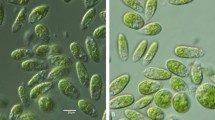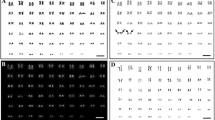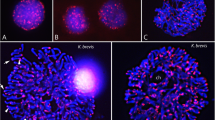Abstract
Ulva linza is one of the species that causes green tides in the Yellow Sea, China. Due to the difficulties in chromosomal preparation, the large numbers of chromosomes, and their relatively small sizes, there have been no reported studies on Ulva macroalgae chromosomes. The karyotypes and chromosomes in U. linza were observed after a series of treatments. The chromosomes were pretreated with 0.1% colchicine for 12 h and then mixed with enzymes. The samples were dropped from 30 cm height onto glass slides, which spread out the surface coat. These pretreatments were the optimal chromosomes preparation treatments. The prepared chromosomes were stained with 4′,6-diamidino-2-phenylindole (DAPI), which is a fluorescent probe sensitive and specific to DNA. The chromosome number in the haploid male and female gametophytes was n=9, and was 2n=18 in the diploid sporophytes. The female gametophyte chromosomes were between 0.804 and 2.292 um in size, the male gametophyte chromosomes were between 0.917 and 2.916 µm, and the sporophyte chromosomes were between 0.912 and 2.167 µm. The relative sizes of the chromosomes were used to analyze the karyotypes of the female and male gametophyte chromosomes. The results provide a solid foundation for the basic technique that can be used to localize molecular markers of Ulva chromosomes.
Similar content being viewed by others
References
Berends P, Merz M, Kranz B, Thaler T, Appel D, Rabe S, Blank I, Stressler T, Fischer L. 2015. Optimization of an enzymatic wheat gluten hydrolysis process in an enzyme membrane reactor using a design of experiment approach. European Food Research and Technology, 242(10): 1735–1746.
Burrell P C. 1939. Root-tip smear method for difficult material. Stain Technology, 14(4): 147–149.
Chamani E, Tahami S K, Zare N, Asghari-Zakaria R, Mohebodini M, Joyce D. 2012. Effect of different cellulase and pectinase enzyme treatments on protoplast isolation and viability in Lilium ledebeourii bioss. Notulae Botanicae Horti Agrobotanici Cluj-Napoca, 40(2): 123–128.
Cui J J, Shi J T, Zhang J H, Wang L T, Fan S Y, Xu Z Y, Huo Y Z, Zhou Q Y, Lu Y W, He P M. 2018. Rapid expansion of Ulva blooms in the Yellow Sea, China through sexual reproduction and vegetative growth. Marine Pollution Bulletin, 130: 223–228.
Dipakkore S, Reddy C R K, Jha B. 2005. Production and seeding of protoplasts of Porphyra okhaensis (Bangiales, Rhodophyta) in laboratory culture. Journal of Applied Phycology, 17(4): 331–337.
Han W, Chen L P, Zhang J H, Tian X L, Hua L, He Q, Huo Y Z, Yu K F, Shi D J, Ma J H, He P M. 2013. Seasonal variation of dominant free-floating and attached Ulva species in Rudong coastal area, China. Harmful Algae, 28: 46–54.
Hiraoka M, Dan A, Shimada S, Hagihira M, Migita M, Ohno M. 2003. Different life histories of Enteromorpha prolifera (Ulvales, Chlorophyta) from four rivers on Shikoku Island, Japan. Phycologia, 42(3): 275–284.
Kennish M J. 2016. Macroalgae. Netherlands: Springer.
Khan T A, Bhise M P, Lakra W S. 2000. Chromosome manipulation in fish-a review. The Indian Journal of Animal Sciences, 70(2): 213–221.
Kindiger B. 1994. A technique for the preparation of somatic chromosomes of Maize. In: Freeling M, Walbot V eds. The Maize Handbook. Springer, New York.
Lin M S, Comings D E, Alfi O S. 1977. Optical studies of the interaction of 4–6 diamidino-2-phenylindole with DNA and metaphase chromosomes. Chromosoma, 60(1): 15–25.
Liu D Y, Keesing J K, He P M, Wang Z L, Shi Y J, Wang Y J. 2013. The world’s largest macroalgal bloom in the Yellow Sea, China: formation and implications. Estuarine, Coastal and Shelf Science, 129: 2–10.
Liu Y, Bi Y H, Gu J G, Li L H, Zhou Z G. 2012b. Localization of a female-specific marker on the chromosomes of the brown seaweed Saccharina japonica using fluorescence in situ hybridization. PLoS One, 7(11): e48784.
Liu Y, Bi Y H, Zhou Z G. 2012a. Karyological observation on Saccharina japonica chromosomes stained with DAPI. Journal of Fisheries of China, 36(1): 50–54. (in Chinese with English abstract)
Namboodiri A N. 1973. Colchicine pretreatment and maceration for improved squashes of dipterocarpaceae. Stain Technology, 48(2): 98–100.
Nichols C. 1941. Spontaneous chromosome aberrations in allium. Genetics, 26(1): 89–100.
Oliveira L, Bisalputra T, Antia N J. 1980. Ultrastructural observation of the surface coat of Dunaliella tertiolecta from staining with cationic dyes and enzyme treatments. New Phytologist, 85(3): 385–392.
Peterfi L S, Manton I. 1986. Observations with the electron microscope on Asteromonas gracilis Artari emend. (Stephanoptera gracilis (Artari) Wisl.), with some comparative observations on Dunaliella sp. British PhycologicalBulletin, 3(3): 423–440.
Raikar S V, Braun R H, Bryant C, Conner A J, Christey M C. 2008. Efficient isolation, culture and regeneration of Lotus corniculatus protoplasts. Plant Biotechnology Reports, 2(3): 171.
Schweizer D. 1976. Reverse fluorescent chromosome banding with chromomycin and DAPI. Chromosoma, 58(4): 307–324.
Tan I H, Blomster J, Hansen G, Leskinen E, Maggs C A, Mann D G, Sluiman H J, Stanhope M J. 1999. Molecular phylogenetic evidence for a reversible morphogenetic switch controlling the gross morphology of two common genera of green seaweeds, Ulva and Enteromorpha. Molecular Biology and Evolution, 16(8): 1011–1018.
Teasdale R D, Rugini E. 1983. Preparation of viable protoplasts from suspension-cultured loblolly pine (Pinus taeda) cells and subsequent regeneration to callus. Plant Cell, Tissue and Organ Culture, 2(3): 253–261.
Wang K, Yu W C. 2016. Chromosome preparation in Rice (Oryza sativa). Current Protocols in Plant Biology, 1(1): 67–77.
Wang S Y, Huo Y Z, Zhang J H, Cui J J, Wang Y, Yang L L, Zhou Q Y, Lu Y W, Yu K F, He P M. 2018. Variations of dominant free-floating Ulva species in the source area for the world’s largest macroalgal blooms, China: differences of ecological tolerance. Harmful Algae, 74: 58–66.
White G B. 1973. Comparative studies on sibling species of the Anopheles gambiae Giles complex (Dipt., Culicidae). III. The distribution, ecology, behaviour and vectorial importance of species D in Bwamba County, Uganda, with an analysis of biological, ecological, morphological and cytogenetical relationships of Ugandan species D. Bulletin of Entomological Research, 63(1): 65–97.
Xu C H, Yu W C. 2016. Artificial chromosomes in Rice (Oryza sativa). Current Protocols in Plant Biology, 1(1): 107–120.
Yabu H, Yasui H. 1991. Chromosome number in four species of Laminaria (Phaeophyta). Japanese Journal of Phycology, 39: 185–187.
Zhang J H, Huo Y Z, Wu H L, Yu K F, Kim J K, Yarish C, Qin Y T, Liu C C, Xu R, He P M. 2014. The origin of the Ulva macroalgal blooms in the Yellow Sea in 2013. Marine Pollution Bulletin, 89(1–2): 276–283.
Zhang J H, Liu C C, Yang L L, Gao S, Ji X, Huo Y Z, Yu K F, Xu R, He P M. 2015. The source of the Ulva blooms in the East China Sea by the combination of morphological, molecular and numerical analysis. Estuarine, Coastal and Shelf Science, 164: 418–424.
Zhao H J, Zhang B, Chen A P, Li P Y, Xiao Y. 2008. Effects of different enzymolysis conditions on the cotyledons protoplast isolation of Alfalfa. ActaAgrestia Sinica, 16(1): 50–53. (in Chinese with English abstract)
Zhou L J, Wang L K, Zhang J H, Cai C E, He P M. 2016. Complete mitochondrial genome of Ulva linza, one of the causal species of green macroalgal blooms in Yellow Sea, China. Mitochondrial DNA Part B, 1(1): 31–33.
Author information
Authors and Affiliations
Corresponding authors
Additional information
Data Availability Statement
The datasets generated and/or analyzed during the current study are available from the corresponding author on reasonable request.
Supported by the National Key R&D Program of China (No. 2018YFD0901500), the Shanghai Sailing Program (No. 17YF1407900), the National Natural Science Foundation of China (No. 41576163), and the Ocean Public Welfare Scientific Research Project, China (No. 201205010)
Rights and permissions
About this article
Cite this article
Zhao, X., Yang, X., Zhang, J. et al. Karyological observations of Ulva linza chromosomes. J. Ocean. Limnol. 39, 259–265 (2021). https://doi.org/10.1007/s00343-020-9105-x
Received:
Accepted:
Published:
Issue Date:
DOI: https://doi.org/10.1007/s00343-020-9105-x




